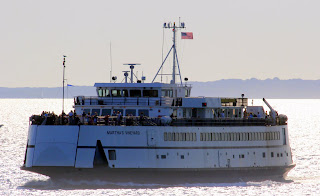Yesterday, the news broke that a group called "Californians for Renewable Energy" (CARE) filed a complaint with the Federal Energy Regulatory Commission (FERC)
challenging Cape Wind's power purchase agreement with National Grid. In its complaint, CARE asks FERC to set aside the November 2010 order of the Massachusetts Department of Public Utilities (DPU)
approving Cape Wind's power purchase agreement with National Grid. CARE also points serious allegations against a variety of parties including National Grid, Cape Wind, and the DPU itself. These allegations range from technical legal points (e.g. that FERC alone has "exclusive jurisdiction to regulate the rates, terms and conditions of sales for resale of electric energy in interstate commerce by public utilities") to rather disjointed but sensational accusations of connections between wind developers and Italian organized crime.
I've read the Complaint, and this morning, I had a pleasant discussion with Mark Rodgers, Cape Wind's Director of Communications. Mark described CARE's complaint as "baseless", and characterized CARE's allegations of an Italian mafia connection as "false, malicious, and defamatory".
Looking at the Complaint itself, I would personally characterize it as a mix of legal argument and wild conspiracy-theory accusations. On the legal argument side, the Complaint appears to allege that the Massachusetts DPU exceeded its jurisdictional authority in approving the PPA. This argument is based on the recent precedent in which FERC told the California Public Utilities Commission that its feed-in tariff program was invalid because it purported to set wholesale rates for power at the state level. Reasoning by analogy, CARE appears to argue that the DPU improperly set a wholesale rate for power in excess of the utility's avoided cost.
Other legal arguments asserted by CARE strike me as more tenuous. For example, CARE asserts that renewable energy credits (RECs) are "greenhouse gas (GHG) offsets", as well as "a type of energy ancillary service that Mass DPU maintains authority over in regard to the price that is paid wholesale Sellers [sic]". CARE goes on to say, "The REC’s purpose therefore is to offset greenhouse gas emissions by avoidance." This is a troubled argument at best. In general, RECs are distinct from GHG offsets; RECs represent the attributes associated with the generation of energy from state-qualified renewable resources, not the specific amount of GHG emission reductions associated with that generation. RECs exist in compliance markets because state legislatures establish renewable portfolio standards requiring specified amounts of energy to be sourced from renewable resources, and do not generally have an explicit GHG tie-in. Further, REC pricing is generally established through bilateral contracts between parties. While a state utility commission like the DPU does retain authority over utilities in its jurisdiction, state commissions do not necessarily specify the price of RECs.
The second half of the Complaint gets even farther out. In a rambling set of long sentences and quotes from emails sent by CARE and its co-complainant Barbara Durkin, CARE alleges that National Grid and the DPU aided and abetted "fraudulent actions and claims to defraud taxpayers of ARRA stimulus funds". This section, which appears largely to be a rehash of the complainants' earlier position before the DPU, includes a request for FERC to "investigate Cape Wind, National Grid, the Massachusetts Attorney General, and Mass DPU for actions they have taken to aid and abet (act as an accessory to) Cape Wind’s fraudulent actions and claims whose purpose is to defraud taxpayers and ratepayers alike of ARRA stimulus funds". CARE goes so far as to assert that when a National Grid representative said “We have every reason to believe that [the production and investment tax credits] are going to be extended and supported by Congress,” this somehow constituted an admission of a violation of the prohibition on energy market manipulation. (This claim is a real head-scratcher.)
Then, if possible, things get even stranger. CARE devotes 24 pages (nearly the remainder of the complaint) to a series of purported quotes from news media stories and other documents about various wind developers (puzzlingly, including developers other than Cape Wind Associates) and connections to Italian organized crime. I won't bother to recite those allegations further here. Suffice to say that this section of CARE's complaint is wild, disorganized, and fails to effectively illustrate any concrete misdeeds by any of the parties against whom CARE complains.
Clearly, this complaint is sensational. Even trying to read between the lines, it is hard to make sense of many of CARE's claims. While the legal issues regarding whether a state has the authority to approve such a PPA are indeed interesting, particularly in the wake of FERC's restrictions on the California feed-in tariff program, the conspiracy claims tend to detract from CARE's credibility. It will be interesting to see how FERC's review of this complaint proceeds.







